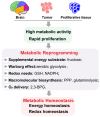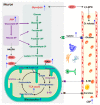Metabolic Reprogramming: Strategy for Ischemic Stroke Treatment by Ischemic Preconditioning
- PMID: 34064579
- PMCID: PMC8151271
- DOI: 10.3390/biology10050424
Metabolic Reprogramming: Strategy for Ischemic Stroke Treatment by Ischemic Preconditioning
Abstract
Stroke is one of the leading causes of death and permanent disability worldwide. Ischemic preconditioning (IPC) is an endogenous protective strategy, which has been reported to exhibit a significant neuroprotective effect in reducing the incidence of ischemic stroke. However, the underlying neuroprotective mechanisms of IPC remain elusive. An increased understanding of the pathogenic mechanisms of stroke and IPC serves to highlight the importance of metabolic reprogramming. In this review, we summarize the metabolic disorder and metabolic plasticity in the incidence and progression of ischemic stroke. We also elaborate how IPC fully mobilizes the metabolic reprogramming to maintain brain metabolic homeostasis, especially for energy and redox homeostasis, and finally protects brain function in the event of an ischemic stroke.
Keywords: ischemic preconditioning (IPC); ischemic stroke; metabolic reprogramming.
Conflict of interest statement
The authors declare no conflict of interest.
Figures




Similar articles
-
Metabolomic Profiling Reveals That Reprogramming of Cerebral Glucose Metabolism Is Involved in Ischemic Preconditioning-Induced Neuroprotection in a Rodent Model of Ischemic Stroke.J Proteome Res. 2019 Jan 4;18(1):57-68. doi: 10.1021/acs.jproteome.8b00339. Epub 2018 Oct 26. J Proteome Res. 2019. PMID: 30362349
-
Endogenous neuroprotective mechanism of ATP2B1 in transcriptional regulation of ischemic preconditioning.Am J Transl Res. 2021 Mar 15;13(3):1170-1183. eCollection 2021. Am J Transl Res. 2021. PMID: 33841647 Free PMC article.
-
Ischemic preconditioning provides long-lasting neuroprotection against ischemic stroke: The role of Nrf2.Exp Neurol. 2020 Mar;325:113142. doi: 10.1016/j.expneurol.2019.113142. Epub 2019 Dec 5. Exp Neurol. 2020. PMID: 31812555 Free PMC article.
-
Mechanisms of ischemic preconditioning.Shock. 1997 Aug;8(2):86-94. doi: 10.1097/00024382-199708000-00003. Shock. 1997. PMID: 9261897 Review.
-
Genetics and genomics of ischemic tolerance: focus on cardiac and cerebral ischemic preconditioning.Pharmacogenomics. 2012 Nov;13(15):1741-57. doi: 10.2217/pgs.12.157. Pharmacogenomics. 2012. PMID: 23171338 Review.
Cited by
-
Neuroglia Cells Transcriptomic in Brain Development, Aging and Neurodegenerative Diseases.Aging Dis. 2023 Feb 1;14(1):63-83. doi: 10.14336/AD.2022.0621. eCollection 2023 Feb 1. Aging Dis. 2023. PMID: 36818562 Free PMC article. Review.
-
Non-histone lactylation: unveiling its functional significance.Front Cell Dev Biol. 2025 Jan 24;13:1535611. doi: 10.3389/fcell.2025.1535611. eCollection 2025. Front Cell Dev Biol. 2025. PMID: 39925738 Free PMC article. Review.
-
Activation of the hypoxia-inducible factor pathway protects against acute ischemic stroke by reprogramming central carbon metabolism.Theranostics. 2024 Apr 29;14(7):2856-2880. doi: 10.7150/thno.88223. eCollection 2024. Theranostics. 2024. PMID: 38773968 Free PMC article.
-
Heptanoic and medium branched-chain fatty acids as anaplerotic treatment for medium chain acyl-CoA dehydrogenase deficiency.Mol Genet Metab. 2023 Nov;140(3):107689. doi: 10.1016/j.ymgme.2023.107689. Epub 2023 Aug 25. Mol Genet Metab. 2023. PMID: 37660571 Free PMC article.
-
Quantum based effects of therapeutic nuclear magnetic resonance persistently reduce glycolysis.iScience. 2022 Nov 9;25(12):105536. doi: 10.1016/j.isci.2022.105536. eCollection 2022 Dec 22. iScience. 2022. PMID: 36444297 Free PMC article.
References
-
- Zhou M., Wang H., Zeng X., Yin P., Zhu J., Chen W., Li X., Wang L., Wang L., Liu Y., et al. Mortality, morbidity, and risk factors in China and its provinces, 1990–2017: A systematic analysis for the Global Burden of Disease Study 2017. Lancet. 2019;394:1145–1158. doi: 10.1016/S0140-6736(19)30427-1. - DOI - PMC - PubMed
-
- Chen S.Y., Liu J.W., Wang Y.H., Huang J.Y., Chen S.C., Yang S.F., Wang P.H. The Conditions Under Which Piracetam Is Used and the Factors That Can Improve National Institute of Health Stroke Scale Score in Ischemic Stroke Patients and the Importance of Previously Unnoticed Factors from a Hospital-Based Observational Study in Taiwan. J. Clin. Med. 2019;8:122. doi: 10.3390/jcm8010122. - DOI - PMC - PubMed
Publication types
Grants and funding
LinkOut - more resources
Full Text Sources

